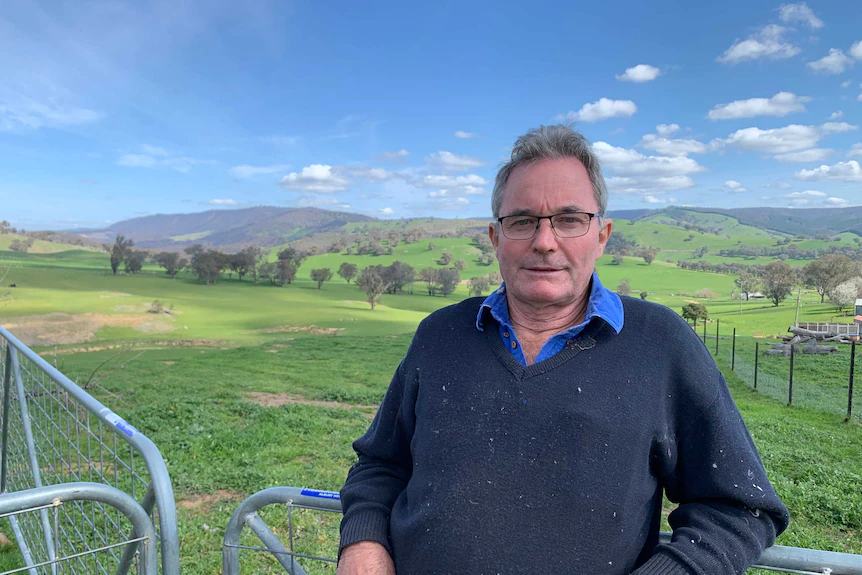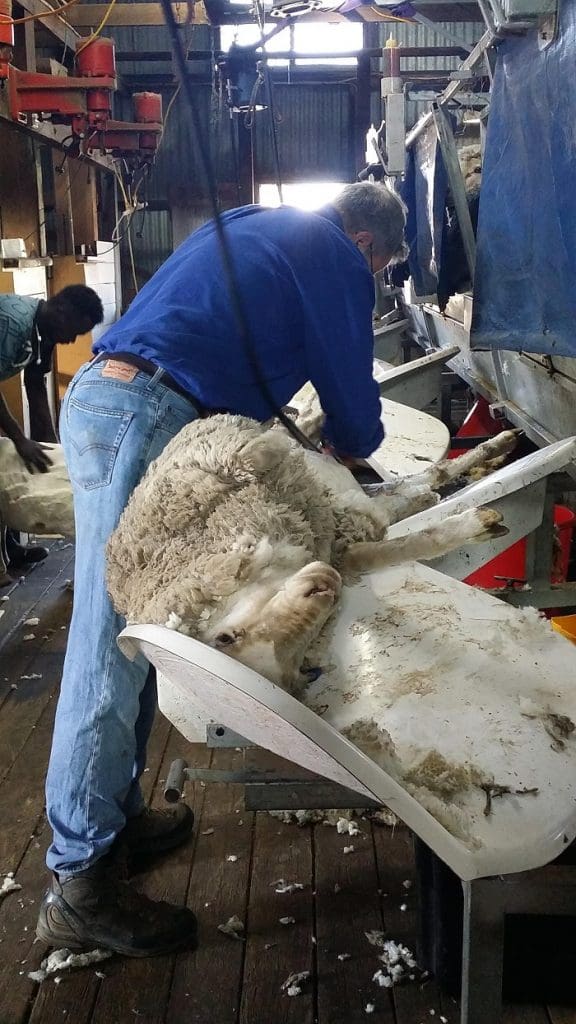
2021 SALRC livestock producer award winner Grant Burbidge.
NEW South Wales wool grower Grant Burbidge has called for more levy spending on research and development after winning the producer section in the 2021 Southern Australia Livestock Research Council awards last week.
Mr Burbidge and his wife Annette run just under 2000 hectares between Tarcutta and Tumbarumba on the South West Slopes of NSW, and 500ha at Simpson in south-west Victoria in conjunction with 300ha owned by their daughter Megan and partner Tim.
The main business is a self-replacing finewool sub-17 micron Merino flock of 2000 ewes mated to Merino rams and 4000 ewes joined to terminals. Wethers are retained to at least three years-old and they run about 100 beef cows.
SALRC chair Ian Rogan asked Mr Burbidge what key issue is a challenge to his business and to the livestock industry generally that SALRC’s R&D partners and investors should be concentrating on.
Mr Burbidge said the latest single issue facing the livestock industry today is the lack of funding of research and development.
“My success in agriculture has predominantly been achieved by collecting research findings from the last seven decades and applying those to our business; however, the quantity of R&D being conducted in the livestock industries has decreased significantly since the 1980s and this has led to reduced productivity gains.
“At the same time as the funding of R&D has been decreasing the amount of funding for extension has been increasing mainly because R&D organisations are trying to justify their existence to levy payers,” he said.
“The last time I did the analysis, only about eight cents in every dollar of my levies to Australian Wool Innovation are truly invested in R&D.”
Mr Burbidge said areas where the industry could achieve large gains with small investments in applied R&D included breech strike, wool harvesting and breeding programs for pastures able to survive a more variable climate.
“Phalaris, in particular, would be very useful and the annuals are not quite as important as the perennials.”
Mr Burbidge said the Sheep Genetics database also needed more commercial application and the production models behind the indexes are not accurate enough.
He said the only highly accurate livestock modelling tool is GrassGro, which once set up properly is a very powerful tool for a specific location.
“What’s needed is an interface that enables Sheep Genetics output to be entered into GrassGro.
“Once this is done, gross margin outputs for 100 years of wether data at any location in southern Australia would be possible,” he said.
“And in doing this it would also be possible to see if the every-increasing trend of ever larger Merinos with higher fertility rates does translate into higher profits per hectare – I think not.”
“I guess the conclusion is that although at the moment with livestock industries booming in a run of good seasons, our views could be somewhat clouded; however, without greater investment in R&D the next generation of farmers will find it harder to make producivity gains necessary to stay ahead of declining terms of trade.”
Climate change, flystrike genetics and wool harvesting

The Burbidge platform shearing system in action in Victoria.
Mr Burbidge said there have been three significant changes to the operation in recent years. These included climate changes or variability leading to expansion into a more reliable rainfall area (Simpson), “where increased temperature and more solar radiation is likely to be beneficial and not detrimental.”
Following on from CSIRO Armidale and Westeran Australian Deparment of Agriculture and Food research, for the last four years the Burbidge ram-breeding flock has used a form of natural selection for resistance to breech strike.
“No progeny are preventatively treated for flystrike and those animals that get breech strike are culled from the ram-breeding nucleus.
“This requires a lot of monitoring to prevent animal welfare issues,” Mr Burbidge said.
He said it’s hoped that the 2000 animals genotyped in his project can be added to the 1500 the CSIRO and the WADA have collected to enable the University of New England to determine a genetic marker for breech strike resistance.
“We probably need about 10,000 animals genotyped to achieve that, so we are still a few years away, and espcially seeing we are about the only ones in Australia doing this work.”
Mr Burbidge said the third area of major change has been in wool harvesting, with his development of a platform shearing system six years ago focussing on “the most efficient method of removing wool from a sheep and placing that wool into bales.”
He said wool harvesting has changed very little in the past 100 years and possibly in 200 years, and is the most expensive and most stressful operation wool growers go through each year.
Mr Burbidge said about 165,000 sheep had been shorn with the system, and it had achieved “the highest quality standards with much less body stress on those doing the words.
“It most situations, it is more cost-effective than conventional shearing.”
The system was at the stage that it could be rolled out to shearer half of Australia’s sheep within five years, but this is highly unlikely to occur, he said.
“The wool industry is not renowned for innovation in thois space and a major would be needed on training and nobody seems interested in doing that.”
Mr Burbidge said he continued to train young people for his team, but at 65 years-old he’s not interested in becoming a shearing contractor.
“If anybody else out there would like to take it one I will give them all the help I can.
“There’s no IP (intellectual property) involved in our system and I haven’t developed it as a business to sell machines,” he said.
“We make equipment available to anybody who wants to have a crack at it.”
He said the system can be seen in operation on https://www.burbidgefarms.com/wool-harvesting.
Mr Rogan said SALRC strongly believes that it wants to recognise excellence and innovation in the livestock industries.
“It’s very much the underlying principle of how SALRC works with our investor members, those are providing research and development services to the livestockindustries, but also to the network of livestock producers that we work with.”
Mr Rogan said 16 nominations were received across the four award categories: a livestock producer, a scientist/researcher, communications/extension professional and a young achiever.
The winner of the 2021 SALRC scientist/researcher excellence award is Dr Wayne Pitchford, a professor and director in livestock science at the University of Adelaide.
The winner of the SALRC communications/extension specialist award is Elke Hocking, a sheep and cattle producer at Lucindale in South Australia, who also serves in industry consultancy and advisory roles.
The SALRC young achiever award winner is NSW Local Land Services officer Tanisha Shields based at Balranald.

Grab and drag has always been a major ‘long-term’ injury area. This system offers some advantages but also has some unacceptable OHS issues which are apparently accepted. An interesting comparison would be say 1000 sheep shorn the traditional way by an experienced shearer and the same shearer doing ‘this way’. Also interesting would be contract cost comparisons.